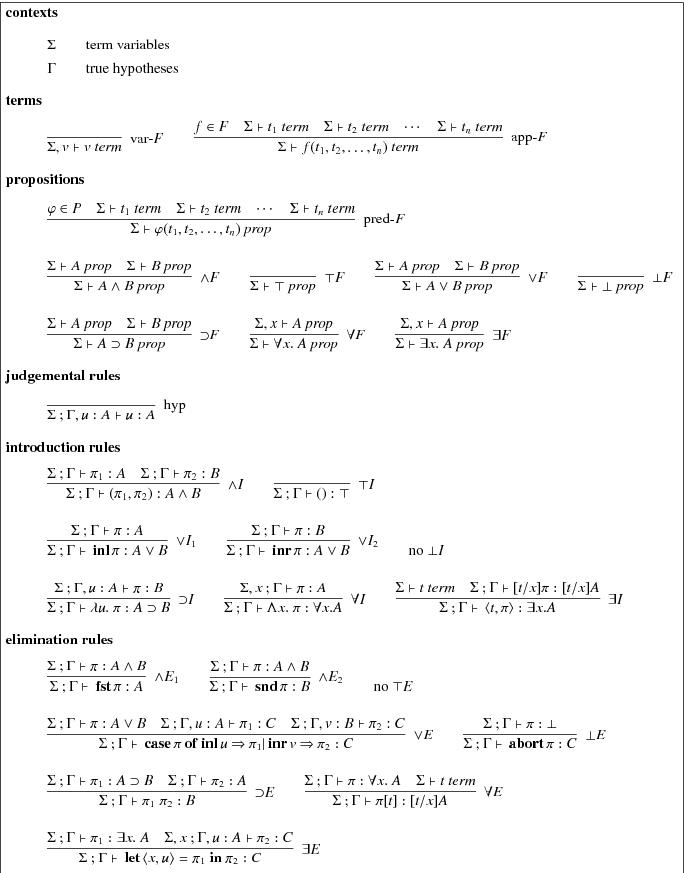|
Gentzen
Gerhard Karl Erich Gentzen (24 November 1909 – 4 August 1945) was a German mathematician and logician. He made major contributions to the foundations of mathematics, proof theory, especially on natural deduction and sequent calculus. He died of starvation in a Soviet prison camp in Prague in 1945, having been interned as a German national after the Second World War. Life and career Gentzen was a student of Paul Bernays at the University of Göttingen. Bernays was fired as "non-Aryan" in April 1933 and therefore Hermann Weyl formally acted as his supervisor. Gentzen joined the Sturmabteilung in November 1933 although he was by no means compelled to do so. Nevertheless he kept in contact with Bernays until the beginning of the Second World War. In 1935, he corresponded with Abraham Fraenkel in Jerusalem and was implicated by the Nazi teachers' union as one who "keeps contacts to the Chosen People." In 1935 and 1936, Hermann Weyl, head of the Göttingen mathematics department in 1 ... [...More Info...] [...Related Items...] OR: [Wikipedia] [Google] [Baidu] |
Sequent Calculus
In mathematical logic, sequent calculus is a style of formal logical argumentation in which every line of a proof is a conditional tautology (called a sequent by Gerhard Gentzen) instead of an unconditional tautology. Each conditional tautology is inferred from other conditional tautologies on earlier lines in a formal argument according to rules and procedures of inference, giving a better approximation to the natural style of deduction used by mathematicians than to David Hilbert's earlier style of formal logic, in which every line was an unconditional tautology. More subtle distinctions may exist; for example, propositions may implicitly depend upon non-logical axioms. In that case, sequents signify conditional theorems in a first-order language rather than conditional tautologies. Sequent calculus is one of several extant styles of proof calculus for expressing line-by-line logical arguments. * Hilbert style. Every line is an unconditional tautology (or theorem). * Gentzen s ... [...More Info...] [...Related Items...] OR: [Wikipedia] [Google] [Baidu] |
Natural Deduction
In logic and proof theory, natural deduction is a kind of proof calculus in which logical reasoning is expressed by inference rules closely related to the "natural" way of reasoning. This contrasts with Hilbert-style systems, which instead use axioms as much as possible to express the logical laws of deductive reasoning. Motivation Natural deduction grew out of a context of dissatisfaction with the axiomatizations of deductive reasoning common to the systems of Hilbert, Frege, and Russell (see, e.g., Hilbert system). Such axiomatizations were most famously used by Russell and Whitehead in their mathematical treatise ''Principia Mathematica''. Spurred on by a series of seminars in Poland in 1926 by Łukasiewicz that advocated a more natural treatment of logic, Jaśkowski made the earliest attempts at defining a more natural deduction, first in 1929 using a diagrammatic notation, and later updating his proposal in a sequence of papers in 1934 and 1935. His proposals led to diffe ... [...More Info...] [...Related Items...] OR: [Wikipedia] [Google] [Baidu] |
Proof Theory
Proof theory is a major branchAccording to Wang (1981), pp. 3–4, proof theory is one of four domains mathematical logic, together with model theory, axiomatic set theory, and recursion theory. Jon Barwise, Barwise (1978) consists of four corresponding parts, with part D being about "Proof Theory and Constructive Mathematics". of mathematical logic that represents Mathematical proof, proofs as formal mathematical objects, facilitating their analysis by mathematical techniques. Proofs are typically presented as Recursive data type, inductively-defined data structures such as list (computer science), lists, boxed lists, or Tree (data structure), trees, which are constructed according to the axioms and rule of inference, rules of inference of the logical system. Consequently, proof theory is syntax (logic), syntactic in nature, in contrast to model theory, which is Formal semantics (logic), semantic in nature. Some of the major areas of proof theory include structural proof theory, ... [...More Info...] [...Related Items...] OR: [Wikipedia] [Google] [Baidu] |
Cut-elimination Theorem
The cut-elimination theorem (or Gentzen's ''Hauptsatz'') is the central result establishing the significance of the sequent calculus. It was originally proved by Gerhard Gentzen in his landmark 1934 paper "Investigations in Logical Deduction" for the systems LJ and LK formalising intuitionistic and classical logic respectively. The cut-elimination theorem states that any judgement that possesses a proof in the sequent calculus making use of the cut rule also possesses a cut-free proof, that is, a proof that does not make use of the cut rule. The cut rule A sequent is a logical expression relating multiple formulas, in the form , which is to be read as proves , and (as glossed by Gentzen) should be understood as equivalent to the truth-function "If (A_1 and A_2 and A_3 …) then (B_1 or B_2 or B_3 …)." Note that the left-hand side (LHS) is a conjunction (and) and the right-hand side (RHS) is a disjunction (or). The LHS may have arbitrarily many or few formulae; when the LH ... [...More Info...] [...Related Items...] OR: [Wikipedia] [Google] [Baidu] |
Proof-theoretic Semantics
Proof-theoretic semantics is an approach to the semantics of logic that attempts to locate the meaning of propositions and logical connectives not in terms of interpretation Interpretation may refer to: Culture * Aesthetic interpretation, an explanation of the meaning of a work of art * Allegorical interpretation, an approach that assumes a text should not be interpreted literally * Dramatic Interpretation, an event ...s, as in Tarskian approaches to semantics, but in the role that the proposition or logical connective plays within the system of inference. Overview Gerhard Gentzen is the founder of proof-theoretic semantics, providing the formal basis for it in his account of cut-elimination for the sequent calculus, and some provocative philosophical remarks about locating the meaning of logical connectives in their Natural_deduction#Introduction_and_elimination, introduction rules within natural deduction. The history of proof-theoretic semantics since then has been devo ... [...More Info...] [...Related Items...] OR: [Wikipedia] [Google] [Baidu] |

